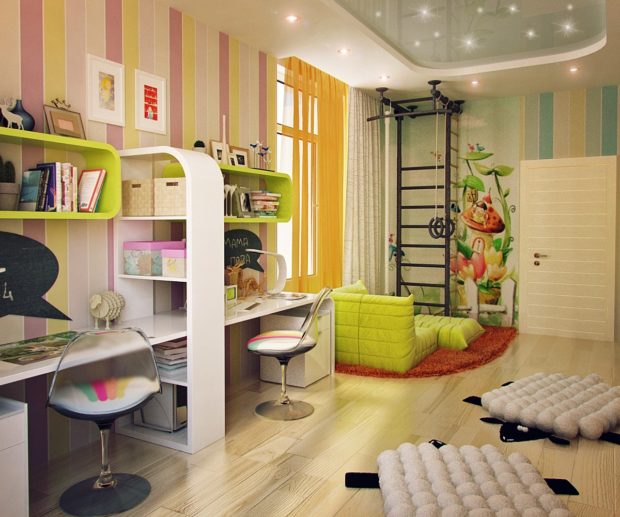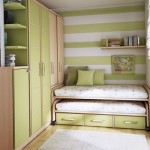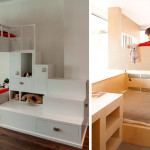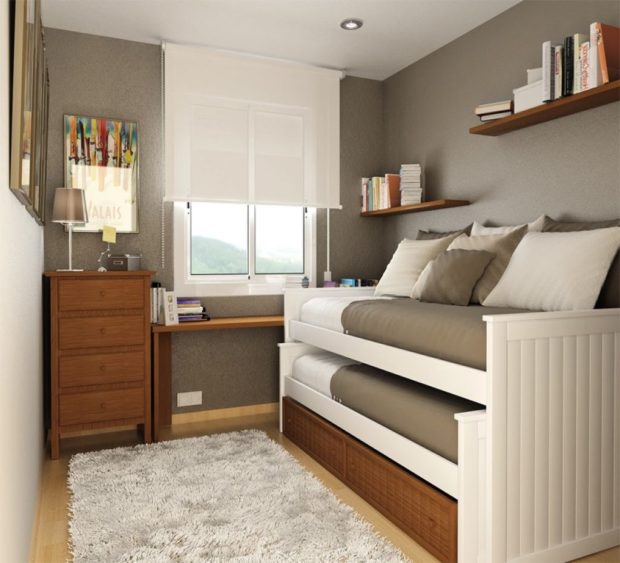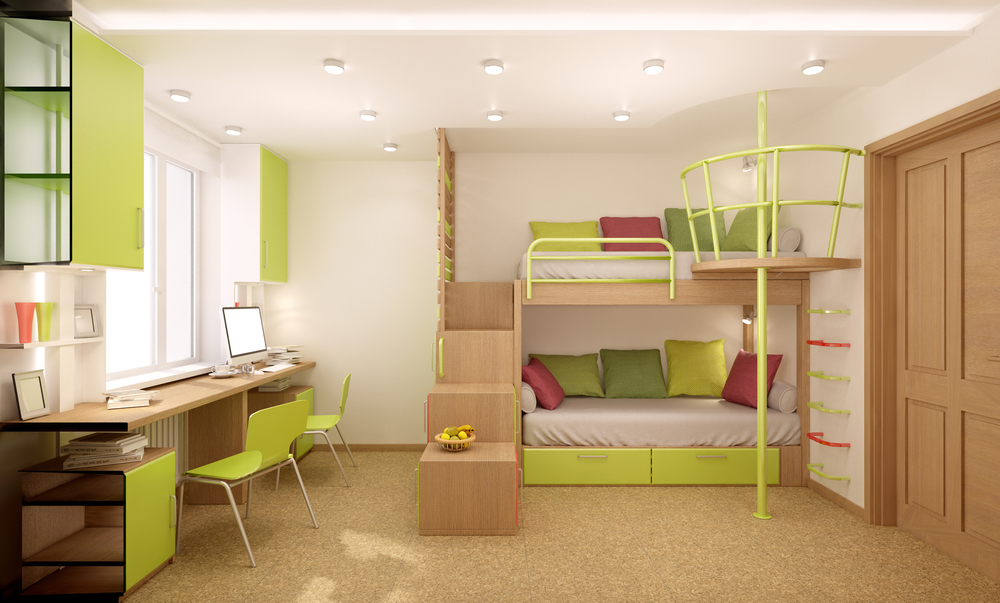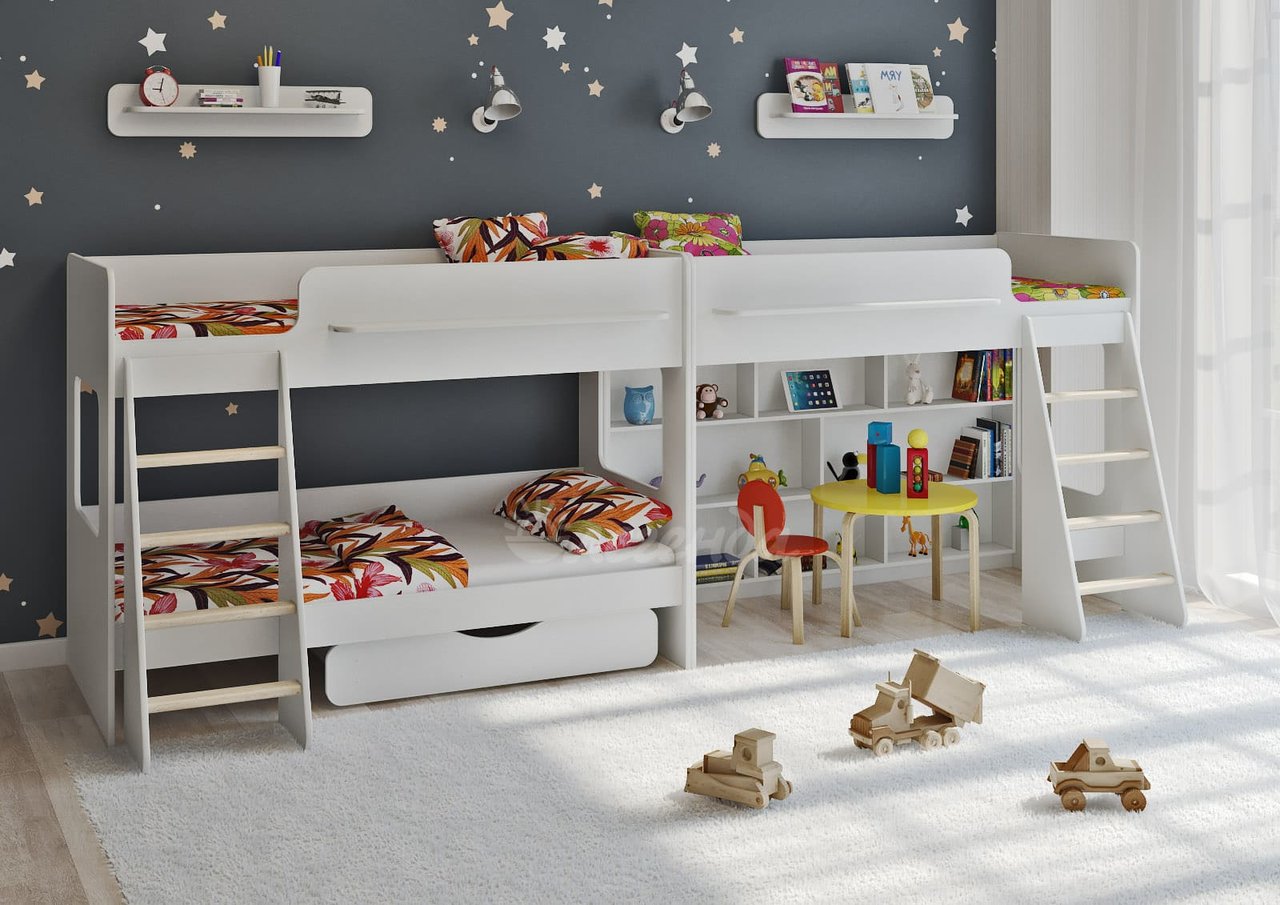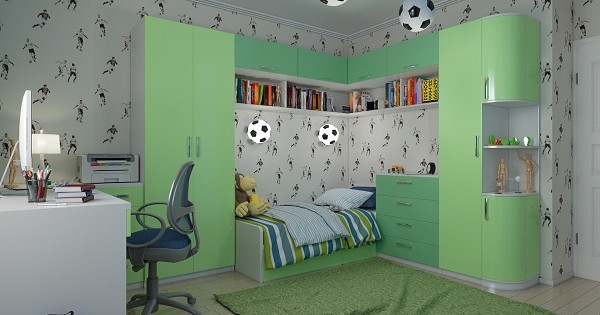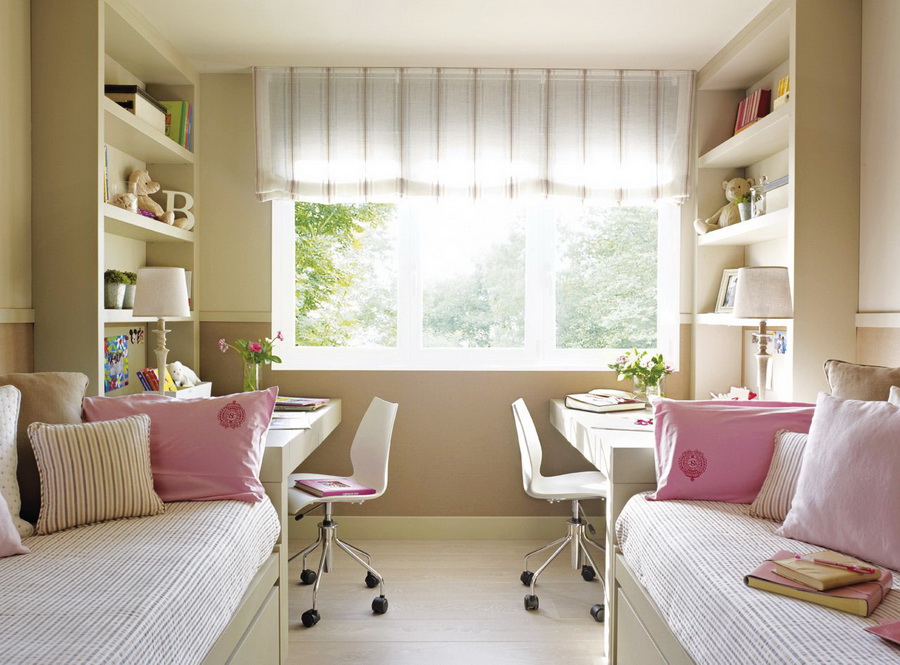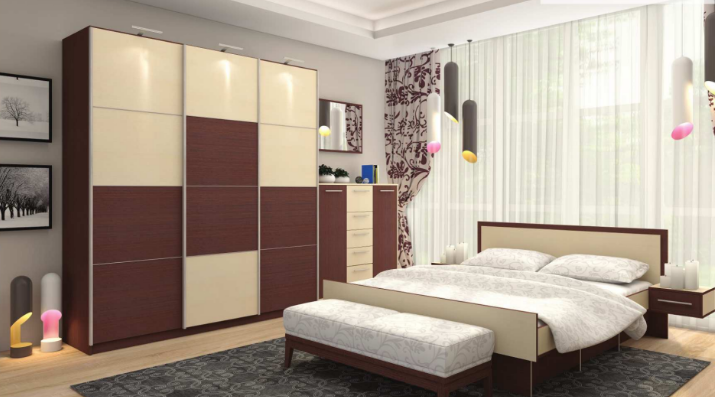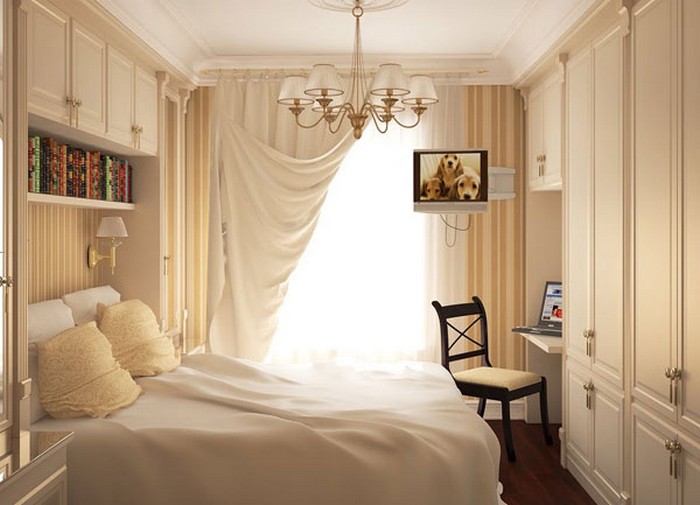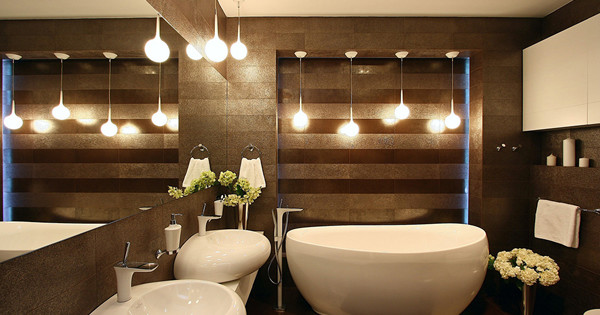7 tips for designing a small children's room + interior photos
It would seem that a small room for a child, a small person, should not become a problem, because everything seems to be proportional. No matter how! If for an adult, his room is a place of rest and sleep, then a child’s room is not only his bedroom, but also a place for study, games, creativity and storage. One small space will be able to perform so many functions only with a very competent approach to planning, choosing furniture and organizing lighting. The task is complicated if several kids grow up in a family at once. However, to execute the competent design of a small children's room is within the power of all parents who will take into account several simple rules and tips.
No. 1. Which nursery is considered small, and does it have pluses?
Today a small one is called a children's room, the area of which is 8-12 m2, and the space of 12 squares is not so small if we talk about one child, but still not large enough for several children. The problem of small children’s lies in the initial layout of the apartments and the inability to choose another baby room. The approach is such that the child is allocated almost the smallest room in the apartment, where an adult bedroom with a huge wardrobe You can’t post it in any way.
If you carefully consider the arrangement of the interior of a small children's room, then from a small area you can draw only advantages. For a preschooler, this will be a cozy corner, and no matter how many toys you don’t throw around, they will be easy to assemble - everything is at hand. For a teenager, a small room means complete untouchability, because parents certainly will not put a closet with clothes here - there simply will not be a place for him, which means that personal space will not turn into a passage yard. A small room can be comfortable and accommodate everything you need, but it is only important to approach its layout responsibly.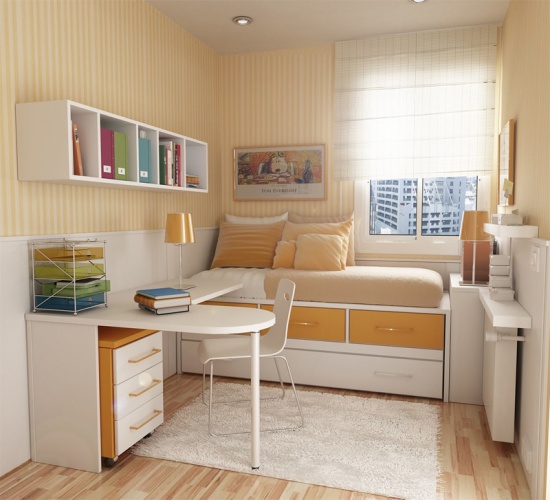
No. 2. Zoning a small children's room
No matter how tiny the child’s room is, it is necessary to place the following zones in it:
- sleep zone;
- work area and area for creativity;
- storage area;
- sports area and a zone of games, which, as the children grow, turn into a recreation area or are assigned to hobbies.

The main difficulty lies in the fact that for most children it is difficult to concentrate on one lesson, and getting into the field of view of toys when the kid does his homework will provoke him to be distracted. There are plenty of examples, and the simplest solution, which was developed by designers together with children's psychologists, is organize the interior so that things that are related to what he is currently doing get into the child’s field of vision. That is why it is so important to create separate areas for study, games and sleep, as well as highlight their boundaries.
Zoning tasks are best suited furniture arrangement around the room. Such a layout is also convenient from the point of view of freeing up space for outdoor games in the center of the room.Highlighting areas is best done with the color of the finish or lighting.
No. 3. Child's age and necessary furniture
The main problem that parents have to solve is proper arrangement of furniture and deciding which items are badly needed and which you can refuse. It’s better to donate some kind of locker, but make more space for outdoor games and sports. If we are talking about a teenager’s room, it’s better if he himself will take part in its arrangement, as he is already able to decide what and where should be for his maximum convenience.
Besides that furniture is better to arrange around the perimeter, there is still several universal rules:
- it is better to give preference to minimally decorated, laconic furniture;
- the fewer angles, the better;
- friends of a small room are tall and narrow pieces of furniture, but you should not build cabinets up to the ceiling, otherwise you can make a small space even more tiny.
Children's room is one of those rooms in the apartment where it is impossible make repairs and for 10 years forget about the need to refresh it. As the child grows, it will be necessary to update furniture and decoration, and each time the needs of the child will change. This means that the approach to the arrangement of the interior of the children's room will also be transformed. In this context, it will be more convenient to consider the basics of furnishing a small children's room, depending on the age of the child.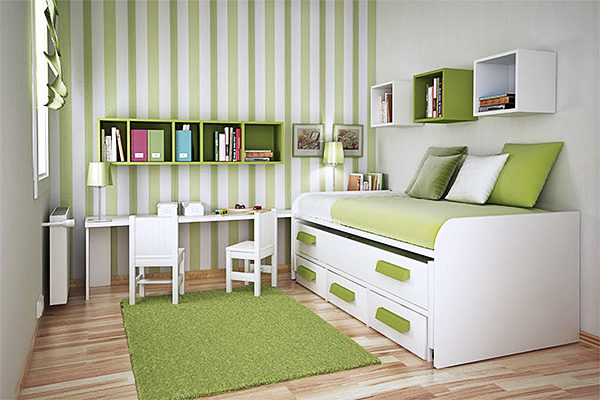
Furniture for baby and preschooler
Newly-made parents will not have to rack their brains for a long time over the arrangement of the nursery. All that is needed is a crib, a changing table in a sufficiently lit place, a small chest of drawers for children's things, and a chair for mom. Later it will be possible to supplement the interior with a soft rug and a box with the first toys.
As the child gets to his feet and begins to consciously get acquainted with the world around him, the first redevelopment of the room is done. You will need another bed, its size is better to take with a margin. It’s good to get a spacious chest of drawers or a wardrobe for children's things, as well as a small children's table and chair, which will become a prototype of the future workplace.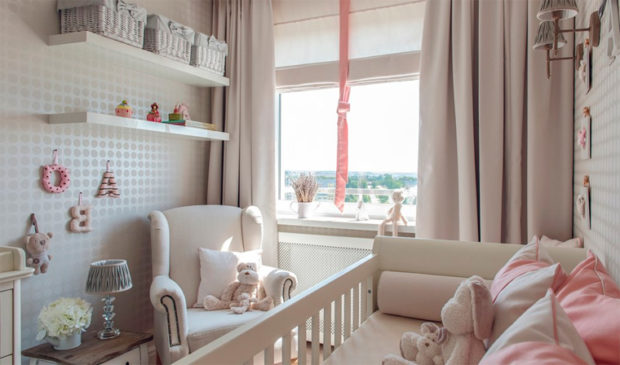
The rest of the area should be free for active games. It’s appropriate for a preschooler to organize sports section. Today, ready-made complexes are sold, which are easy to assemble and install. They can be of any size, and with a shortage of space you can stop at mini corner with parameters 80 * 60 cm.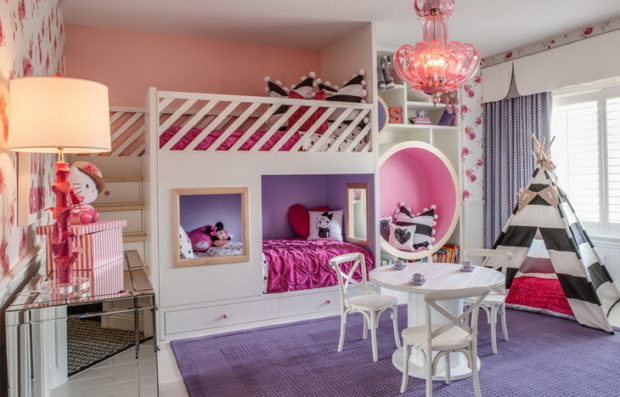
Preschool children love to draw. To wallpaper is not affected, some parents are worried in advance about sticking special wallpapers for drawing on one wall: they outline the contours of numerous figures that the kids have to paint. Another option is to highlight a wall or part of it to showcase the best work.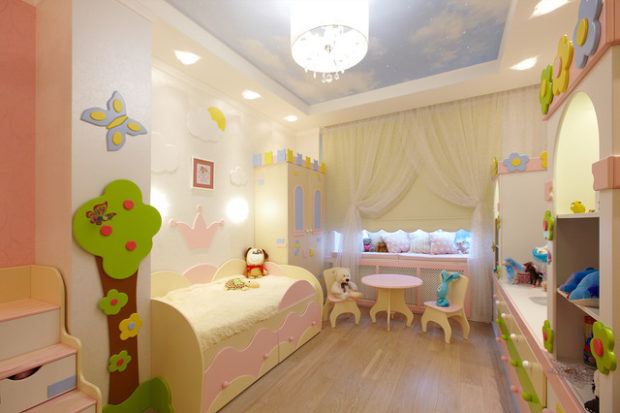
The worst enemy of a small space is a mess, which, as you know, is becoming synonymous with the nursery. To make space perceived more spacious, it is necessary to provide storage space for toys. It can be either ordinary closed shelves and cabinets, or interesting baskets or chests - it all depends on the style of the room.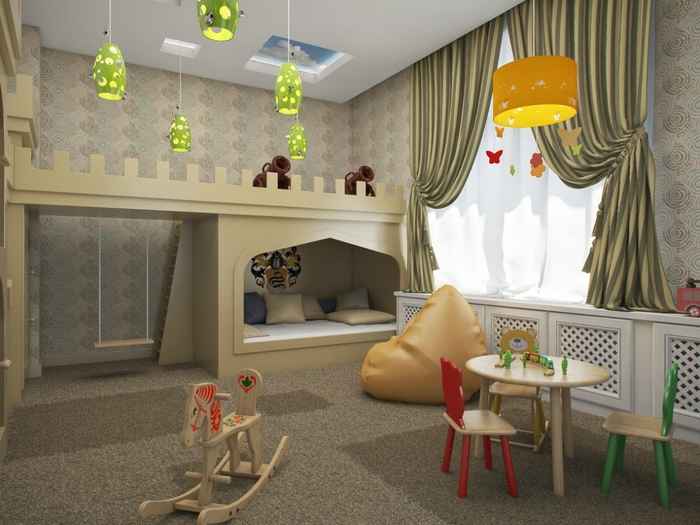
Furniture for the younger student
From the moment the child goes to school, it is important to teach him to clearly divide the time into classes and play, so the work and play areas should be well-separated from each other. Let be work zone will be compact, but isolated from others, which can be done by placing it at a low catwalk, by the wall or by the window, so that the play area remains behind. Perfect ready complexesin which there is a bed on the second tier and a work table with the necessary shelves and drawers on the first tier, but in this case, most likely, it will be necessary to devote more time to organizing the lighting.Shelves with textbooks and other school supplies are located near the desktop.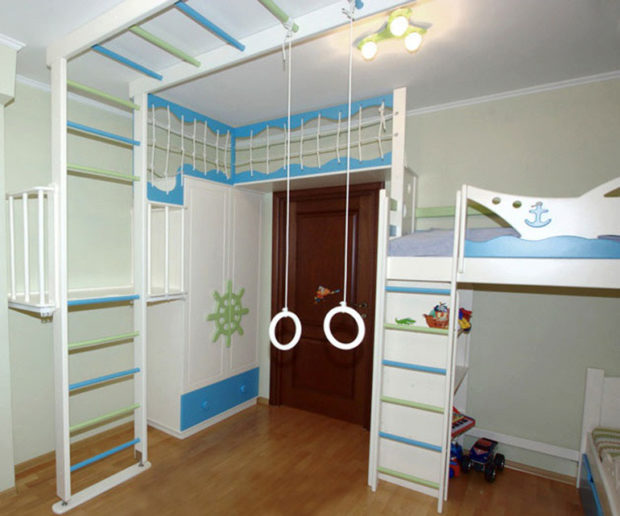
From the age of 6, a child can sleep on the second tier of a bunk bed. The first tier is not necessarily the bed of the youngest child. It can be a work or play corner, or a spacious wardrobe. Moreover, shelves can also be mounted on the steps of the stairs leading to the sleeping area. Thus, the storage problem is solved, and at the same time there is enough space for games and entertainment, which is especially important if there are several children in the family, or the child often has peers.
To make a small children's room visually larger is worth use not very deep cabinets and shelves. Children's things are small, so for now you can use furniture of small depth.
It is better to give the vacated place under a sports complex with a rope, a Swedish wall and rings, or arrange toy houses, huts and other elements that will delight the child.
Small room for a teenager
The principles of organizing a room for a teenager are not much different from the arrangement of the interior of an adult room. The play area disappears, and the work area and recreation area grow along with storage areas. To accommodate everything you need, sometimes you have to place the bed on the second tieruse instead folding sofawhich is not entirely good. Alternative - put the bed on the podium, and its internal space to use for storage.
It is better to think over the design of the room with a teenager who will indicate the preferred interior style. Children at this age often strive for bold decisions, and recently, more and more often teenage rooms are decorated in the loft style and minimalism. Girls usually prefer the Provence and Art Deco styles.
Number 4. Design of a small children's room for two
If the room area is only 8 m2 or so, and two children in a family, the task of parents is many times more complicated. Splitting the room in half will not work. The best option is bunk beds, and if the children are more than 6 years old, then both berths can be placed on the second tier, leaving space under the bed for cabinets and tables. The rest of the place can be used for games and sports.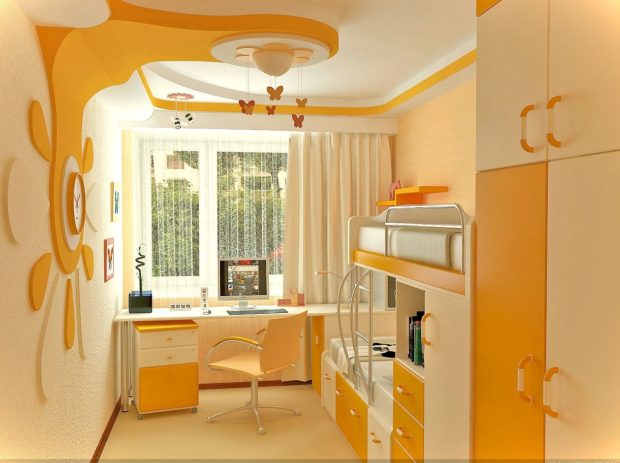
There are bunk beds that do not look different from the most common single beds. Their secret is that a second berth is formed when the lower part of the bed is moved forward.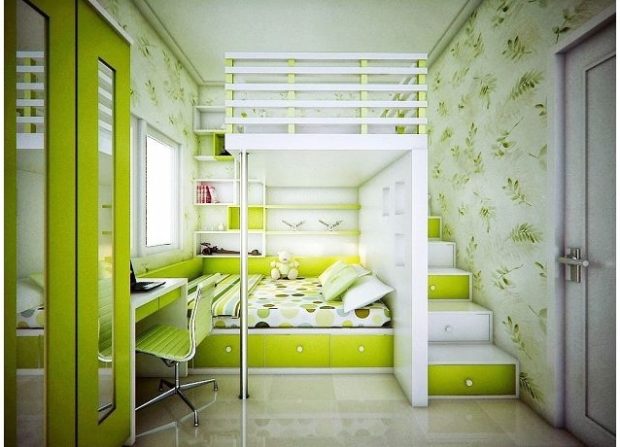
No. 5. Storage system
You can think for a long time about the interior of a small children's room, competently arrange all the zones, but spoil the result with a mess. The more things are located in the room in plain sight, the more the attention of the person entering is scattered, and the smaller the room seems. This is not to mention the fact that the mess makes parents nervous and does not instill anything useful in children.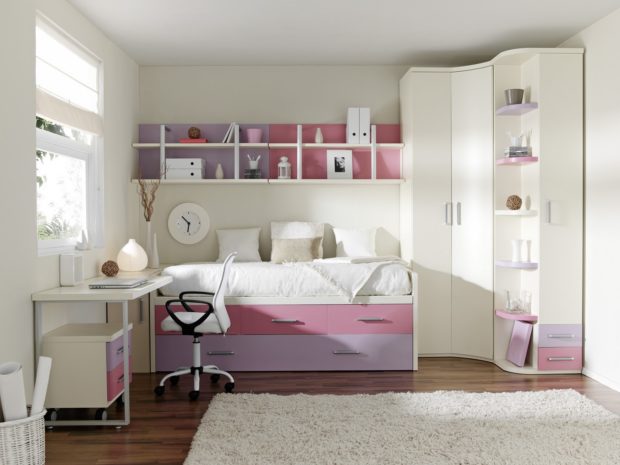
The whole room with cabinets and shelves is not worth hammering. A chest of drawers or a closet can be used to store clothes. The latter can be located under the berth, if the height of the room allows. Separate shelves with clothes can be placed under the bed or on the stairs leading to the sleeping area located at a height.
It is better to use the space around the desktop as much as possible: open shelves and hanging cabinets are suitable. Do not forget to use corners that hide a huge potential. For kids, storage places can be made in the form of baskets, poufs or in the form of cartoon characters.
No. 6. The choice of finishing materials and color scheme
A children's room is a place where the baby will spend a lot of time, and from the very first days of his life. It should be here maximum natural and environmentally friendly materials. From cheap linoleum, plastic panels, chipboard, vinyl wallpaper and the abundance of PVC is better to refuse. On the floor better to lay laminate, parquet or quality linoleum. Carpet also suitable if it is well washed and will not collect a lot of dust. Walls better finish paper wallpaper or paint, ceiling - paint or plaster.
Now for color scheme. Creating the right color design for a small children's room is many times more difficult than rooms for adults, because here you need to choose shades so that the space does not seem even smaller, but at the same time does not make it too boring. Designers recommend that you follow these guidelines.:
- do not use more than 3 colors in the design. Otherwise, the room will seem smaller and annoy its occupant;
- as a basis it is better to take light shades. The ceiling is better to make glossy white, which will visually increase the room. With walls it’s more difficult, because plain-colored wallpapers will seem boring to the baby. The best option is a wallpaper with a characteristic pattern and a light background. It can be images of heroes of fairy tales, cartoons, or just flowers, clouds, funny little animals;
- in nurseries, with windows facing north, it is better to use warm shadesfor example, beige, light pink, light yellow, pale green. If the windows face south, the excess of sunlight can be compensated for by light blue, pale lilac, light gray, or other cold shades;
- necessarily necessary take into account the gender, age and preferences of the child. We omit the traditional division of colors into girls and boys, because the delicate blue color can become the main color in the girl’s room, and the sand color in the boy’s room. Psychologists say that in a room of a child under 7 years old there should be more bright colors and shades, and at an older age they should be replaced by calmer tones.

Children's room is a great field for imagination and creativity. If you take into account, at a young age, tastes and attitude to the world are laid, then the interior of the children's room should not only be thought out, but also original. On 8 m2 you won’t be especially fast, but such a small space can be stylize as a pirate ship, dollhouse or forest clearing.
Number 7. Lighting in the nursery
Bad lighting - the worst enemy of a small nursery in particular and the nursery in general. Lack of light and darkened corners make the space visually smaller. Moreover, poor lighting negatively affects the health of the child, causing a whole range of problems.
Even in spite of the fact that the children's room is small, it is impossible to limit oneself to only one chandelier. Of course, it can be present or can be replaced by rotary spots, but it is better to supplement it with local light. The smaller the area of the nursery, the less voluminous the central chandelier should be.
Local light necessary in the working and play areas, can be used near the bed and wardrobe. Lamps can play not only a purely functional role, but also decorate the space if they are made in a certain style. Ideally, think over the lighting scheme even at the stage of repair, so that all the cables are inside the wall.
No less important to the maximum use natural light. In this regard, an unwritten rule applies: the smaller the window, the more transparent it should be and the less heavy it should be curtains. Great for a little baby rolled, roman and panel curtains, which in the open state allow maximum light into the room, and in the closed state they can become a dense barrier protecting the baby’s sleep.
Finally
Lighting items, wallpaper, furniture - all this can fulfill not only its direct functions, but also decorate the room, so it is important not to overdo it with additional decor. Garlands, bright bedding and floor mats, photographs and crafts made by the hands of the baby.

